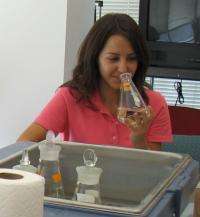Consumers detect odd odors, tastes in water despite government guidelines, scientist says

People are more sensitive to metallic tastes in their water than federal guidelines about taste would suggest, according to a Colorado State University researcher’s manuscript in the Journal of Water and Health.
Through sensory studies, Pinar Omur-Ozbek, research assistant professor in civil and environmental engineering at Colorado State, and Virginia Tech Professor Andrea M. Dietrich found that almost all people identified some metallic taste in their water spiked with iron and copper at various concentrations. The presence of iron and copper in tap water is most likely caused by source water (for example, groundwater) or is a result of pipe corrosion. Groundwater dissolves the metals in the sediments as it trickles down and may contain detectable levels of iron and copper. Corrosion can release very small amounts of copper (and iron) into the drinking water.
The Environmental Protection Agency regulates the amount of copper in drinking water, but provides only guidelines – not regulations – for metallic tastes, as they are not usually a health but an aesthetic issue, Omur-Ozbek said.
“People are more sensitive than the guidelines indicate, which can help municipalities understand why people might complain about their drinking water,” she said. “Even if you don’t have levels of metals that require regulation, people could be tasting levels that are much lower than anticipated according to the EPA guidelines.”
Omur-Ozbek trains water engineers to use their sense of taste and smell to identify the off-tastes and odors in drinking water. Such off-flavors may be caused by pipe corrosion (metallic tastes) or algal metabolites (earthy/musty/fishy odors). Eutrophication of surface water bodies leads to increased algal blooms that lead to release of such odorants.
Omur-Ozbek’s next training workshop on one of the most powerful sensory analysis techniques – called the Flavor Profile Analysis – is scheduled May 19 at Colorado State University. The workshop is co-organized by the American Water Works Association Rocky Mountain Section’s Drinking Water Treatment Committee and includes other topics such as treatment methods for taste-and-odor compounds and speciation of algae. For more information, go to www.rmsawwa.net/PDFs/T&O_Train … t_&_Registration.pdf .
Some of the odors that can be detected in water:
• Algal metabolites such as geosmin and 2-methylisoborneol (2-MIB) can cause earthy or musty odors.
• Another algal metabolitenonadienal, which is also found in cantaloupes and cucumbers, can cause a cucumber or fishy odor.
Even though the algal metabolites do not pose a health risk to consumers, their unpleasant tastes and odors tend to worry them and result in complaints.
Omur-Ozbek has worked with municipalities around Colorado such as the city of Fort Morgan, the city of Loveland and the city of Fort Collins to provide taste-and-odor training.
She has a contract with the city of Loveland to monitor odorous compounds in source and treated water from May through November, when water supplies are more susceptible to algae growth. The city sends her samples every other week, which a trained student tests for odorants for early mitigation actions.
“This recent research and these workshops are designed to help water engineers more quickly diagnose water problems and take faster action to minimize consumer complaints,” Omur-Ozbek said.
Solving taste-and-odor issues is costly for cities because conventional methods do not remove these compounds, which is why city engineers need to know their concentration in the source water and the severity of the problem, she said. Use of analytical instruments to measure odorants can take hours vs. 15 minutes just using sensory techniques.
Omur-Ozbek also developed a simple mathematical formula with her colleagues Dietrich and Dan Gallagher, both faculty members at Virginia Tech, for utility engineers to judge odors released from tap water during showering so they can understand consumer complaints. The formula, which accounts for such factors as odorant concentration, water flow rate and water temperature, tells engineers how much odor should be expected in the air. The formula, along with the model used to develop it, was published this year in Environmental Science and Technology.
Provided by Colorado State University















